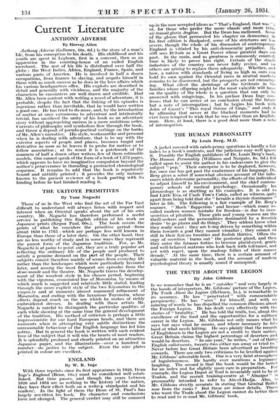THE UKIYOYE PRIMITIVES
By Yone Noguchi
Those of us in the West who find the art of the Far East difficult to understand will always listen with respect -and interest when an _Oriental speaks about the art of his own country. Mr. Noguchi has therefore performed a useful service in publishing this English edition of his work on Japanese prints (Began Paul,;-60s.). - The book covers. the prints of what he considers the primitive period—from about 1650 to 1765—which are perhaps less well known in Europe than those of a later date. On the other hand, they are no less worthy of study and in some ways they represent the purest form of the Japanese tradition. For, as Mr. Noguchi is at pains to point out, they are a truly popular art reflecting the ordinary life of the people and produced to satisfy a genuine demand on the part of the people. Their subjects consist therefore mainly of scenes from everyday life rather than the landscapes which were particularly favoured later, and among the most frequent are episodes from the derni-monde and the theatre. Mr. Noguchi traces the _develop- ment of the woodcut style in his chosen period, beginning with the vigorous, economical line of Moronobu, by means of which much is suggested and relatively little stated, leading through the more explicit style of the two Kiyonobus to the exquiste and at moments almost mannered refinement of Masanobu, and ending with the luxurious Toyonobu, whose effects depend much on the use which he makes of richly embroidered dresses. In dealing with these artists Mr. Noguehi is careful to distinguish the particular qualities of each while showing at the same time the general development of the tradition. His method of criticism is perhaps a little impressionistic for our hard European heads, and there are moments when in attempting very subtle distinctions' the unreasonable behaviour of the English language has led him astray. But in general the book is written with such evident love of the subject that it will win the hearts of most readers. It is splendidly produced and clearly printed on an attractive Japanese paper, and the illustrations—over a hundred in number—do justice to the subject. Even the nine plates printed in colour are excellent.










































 Previous page
Previous page